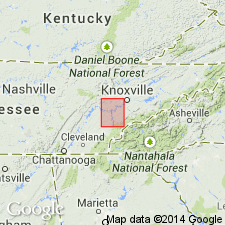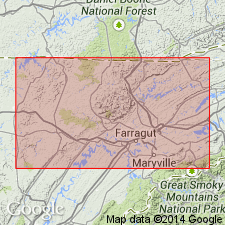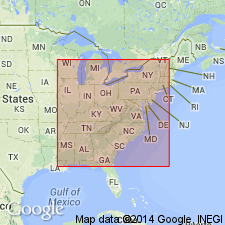
- Usage in publication:
-
- Briceville shale*
- Modifications:
-
- Original reference
- Dominant lithology:
-
- Shale
- Sandstone
- Coal
- AAPG geologic province:
-
- Appalachian basin
Summary:
Pg. 4. Briceville shale [of Pottsville group]. Mainly bluish gray and black fine-grained shale, containing, many small beds of hard sandstone and workable coal seams. Thickness 300 feet or more. Highest formation in Loudon quadrangle. Overlies Lee conglomerate. [In type area (to northeast of Loudon quadrangle) the formation is overlain by Wartburg sandstone, according to USGS folio no. 33; but the formation overlying the Briceville was in 1925 named Jellico formation by L.C. Glenn, and Wartburg sandstone was restricted to a sandstone near middle of Briceville shale, which, according to Glenn, is the sandstone, exposed at Wartburg. These changes of definitions have not been considered by the USGS for its publications.] Age is Pennsylvanian.
[Named from occurrence at Briceville, Anderson Co., eastern TN.]
Source: US geologic names lexicon (USGS Bull. 896, p. 261-262).

- Usage in publication:
-
- Briceville formation
- Modifications:
-
- Revised
- AAPG geologic province:
-
- Appalachian basin
Summary:
Pg. 16. Gave thickness of Briceville formation as 550 to 825 feet, and stated it is now known that there are at least 200 and probably 300 or even more feet of shales belonging to this formation beneath drainage level is Briceville-Coal Creek region, and that 85 percent of formation is shale. Age is Pennsylvanian.
Source: US geologic names lexicon (USGS Bull. 896, p. 261-262).

- Usage in publication:
-
- Briceville Formation†
- Modifications:
-
- Abandoned
- AAPG geologic province:
-
- Appalachian basin
Summary:
Briceville Formation abandoned herein. Previously assigned to strata between Lee Group (old usage) and Jellico Formation. Was approximately equivalent to lower part of Breathitt Formation in KY, lower part of Kanawha Formation in WV, and part of Wise Formation in VA; questionably equivalent to Gladeville Sandstone and upper part of Norton Formation in VA. Strata are now assigned to lower part of Slatestone Formation in TN (Wilson and others, 1956; Hardeman and others, 1966).
Source: GNU records (USGS DDS-6; Reston GNULEX).
For more information, please contact Nancy Stamm, Geologic Names Committee Secretary.
Asterisk (*) indicates published by U.S. Geological Survey authors.
"No current usage" (†) implies that a name has been abandoned or has fallen into disuse. Former usage and, if known, replacement name given in parentheses ( ).
Slash (/) indicates name conflicts with nomenclatural guidelines (CSN, 1933; ACSN, 1961, 1970; NACSN, 1983, 2005, 2021). May be explained within brackets ([ ]).

